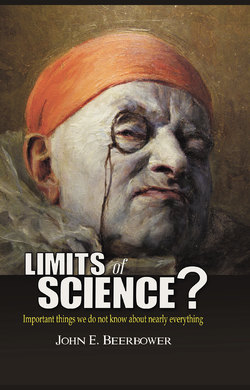Читать книгу Limits of Science? - John E. Beerbower - Страница 6
A priori knowledge
ОглавлениеArkes attributes this conception of causation to Immanuel Kant and Kant’s argument that there are necessary, or a priori, truths that exist independent of experience. He paraphrases and quotes Kant to the effect that “the nature of the rule becomes more evident to us as we see it manifested in any experience… But unless we understand already the immanent necessity of a rule—unless we presuppose that events are indeed arranged in a temporal order, with certain events A preceding certain events B and determining the position of B in the sequence—unless this elementary point is absorbed as a necessary truth, it becomes impossible to impute any meaning to the succession of perceptions that flash before us. As Kant remarked, ‘it is under this supposition only…that an experience of anything that happens becomes possible.’ … [T]he awareness of the rule—the awareness of the very notion of causation—‘was nevertheless the foundation of all experience, and consequently preceded it a priori.’” Id., p.64, quoting from Kant’s Critique of Pure Reason.2 In short, humans have built-in an understanding or, perhaps, an assumption of causality that leads us to look for and enables us to see causal relationships. In fact, it would be asserted, if we did not have an inherent understanding of causality, we would be unable to detect it.
There are other examples of innate or inherent mental constructions or structures, and the same caveats would appear to apply. As an example, the conception of space and time would seem to precede a priori actual experience. Indeed, one could argue that we could not understand our physical experiences without such concepts being given in advance of and as a basis for perceiving those experiences. See Arkes, First Things, pp.56–57.3
Similarly, experiments have demonstrated that our visual perception is based upon certain innate perceptions. For example, the laws of perspective, which were only gradually discovered by Renaissance artists, appear to be embedded in our minds. The point is demonstrated by the adjacent images of the Leaning Tower of Pisa which the mind persistently perceives as diverging, with one tower appearing to lean noticeably more even though the two are identical. The reason is that the mind “knows” that two neighboring towers will appear to lean toward each other as they rise from the ground in a single scene (the law of perspective), so if the towers do not in the photo lean toward each other as they rise, the mind concludes—and the eyes see—that one tower tilts more than the other. Stephen L. Macknik and Susana Martinez-Conde, Sleights of Mind: What the Neuroscience of Magic Reveals About Our Everyday Deceptions (2010), as reported in The Wall Street Journal, November 20–21, 2010, p.C12.
Recent research seems to confirm the suspicions that the human mind is simply incapable of perceiving things objectively—that is, independently of human mental “biases”—or with complete accuracy.4
However, the fact that humans inherently perceive causality (or space and time or perspective) is not itself evidence for the independent truth or accuracy of such perceptions. Arguably, such hard-wiring in the human brain results in the detection of such relationships even where none exists in fact, exhibiting a kind of irrationality. See, e.g., House MD, “Small Sacrifices,” Season 7, Episode 8, November 2010 (in a typically exasperated reaction to religious belief, when he is treating a man who believes that his promise to reenact the crucifixion explains his daughter’s miraculous recovery from cancer, House mutters: “Causal determinism: hard-wired to need to find answers,” a legacy of the caveman for whom the belief in causal relationships was a survival benefit, but which House clearly considers to be irrational where religion is concerned, despite his own obsessive drive to find causation in sources that he considers legitimate).
Undoubtedly, the presence of such hard-wiring would be attributed by many to evolution: for example, the ability to appreciate and perceive causation, spatial relationships and the passage of time all improve the rates survival and reproduction. But, if it is concluded that evolution is the source of such mental constructs, would that be evidence that the constructs reflect reality? As we shall see below, twentieth century developments in physics certainly pose challenges to our preconceptions and perceptions of reality, suggesting that the truths about the Universe (especially at very small and very large scales) may be quite different from what our common sense (and senses) tell us about the world on a human scale.
Perhaps the simplest expression of the main point here is reflected in the statement: “We see with our brains, not with our eyes,” a quotation attributed to Paul Bach-y-Rita, a scientist and rehabilitation physician who developed a “tactile-vision device” that would enable a blind person to “see” by providing electrical stimulation to the brain from the device rather than from the impaired eye. Norman Doidge, MD, The Brain that Changes Itself (2007), p.15. See Paul Bach-y-Rita, et al., “Vision Substitution by Tactile Image Projection,” Nature, 221 (8 March 1969), pp.963–4. In other words, our perceptions of the world are the result of how our brains interpret the inputs received from our senses. See also, Joseph Mazur, The Motion Paradox, p.27 (“the mind, not the eye, is the seeing organ”).
